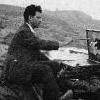

Bogdanove had lived in New York City since 1900, when, at the age of thirteen, he emigrated with his family from Minsk, Russia. The Bogdanoves were part of the large wave of Russian Jewish immigrants who came to America at the turn of the century. Soon after settling in New York, Abraham began studying art at the Cooper Union Institute of Art. In 1903, he entered the National Academy of Design school and, at the same time, served an apprenticeship, painting advertisement displays for the Bull Durham Company in New York. Through this dual education, Bogdanove developed his abilities in design, draftsmanship, and painting. His studies at the academy were directed by the painters George Wiloughby Maynard (1843-1923) and Francis Coates Jones (1857-1932), and by the end of his tenure in 1911, he had earned several honors. For three consecutive years, he received the distinguished annual Hallgarten Prize, which was bestowed upon the three best paintings exhibited at the academy by artists under the age of thirty-five.
Like Robert Henri and Edward Hopper, Bogdanove was inspired by the stark drama of Monhegan Island. Returning there every summer from 1918 until the end of his life, he spent his days hiking onto the rocky outcroppings at the water’s edge, where he applied energetic brushstrokes with vigor and gusto to capture the ever-changing coloristic and compositional possibilities of crashing waves and jagged rocks. Whereas other artists represented saw only gray tones in Monhegan’s rocks, Bogdanove perceived them to be full of color, and he captured their vivacity with a wide-ranging palette. He also chronicled Monhegan’s harbor and fish houses, demonstrating an attention to the form-defining properties of light that parallel Hopper’s. While Bogdanove captured the animated qualities of his subject matter, he also created strong, abstract designs that reflect his understanding of modernist principles.
Website
http://www.bogdanove.com
